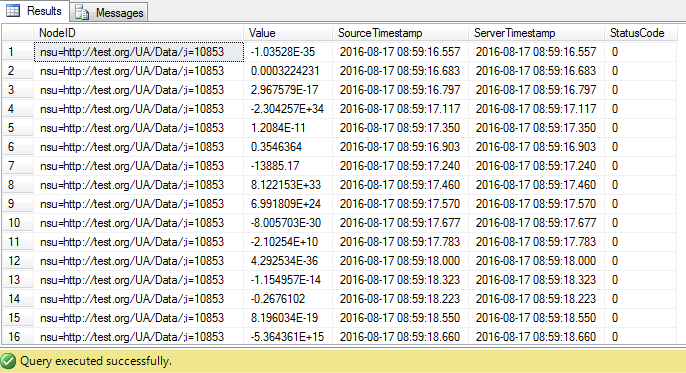How to log OPC Unified Architecture data changes into a SQL Server database
From OPC Labs Knowledge Base
(Redirected from How to log OPC Unified Architecture data changes into an SQL database)
See also: QuickOPC.NET: How to log OPC Data Access item changes into an SQL database.
It is often required that a status of certain process variable is logged into a SQL database. Following example shows how to do that with QuickOPC:
static void Main()
{
const string connectionString =
"Data Source=(local);Initial Catalog=QuickOPCExamples;Integrated Security=true";
Console.WriteLine("Starting up...");
using (var connection = new SqlConnection(connectionString))
{
connection.Open();
// Create all necessary ADO.NET objects.
var adapter = new SqlDataAdapter("SELECT * FROM UASimpleLog", connection);
var dataSet = new DataSet();
adapter.FillSchema(dataSet, SchemaType.Source, "UASimpleLog");
adapter.InsertCommand = new SqlCommandBuilder(adapter).GetInsertCommand();
DataTable table = dataSet.Tables["UASimpleLog"];
Debug.Assert(table != null);
Console.WriteLine("Logging for 30 seconds...");
// Subscribe to an OPC item, using an anonymous method to process the notifications.
int handle = EasyUAClient.SharedInstance.SubscribeDataChange(
"http://opcua.demo-this.com:51211/UA/SampleServer", // or "opc.tcp://opcua.demo-this.com:51210/UA/SampleServer"
"nsu=http://test.org/UA/Data/;i=10853",
100,
(_, eventArgs) =>
{
Debug.Assert(eventArgs != null);
Console.Write(".");
// In this example, we only log valid data. Production logger would also log errors.
if (eventArgs.AttributeData != null)
{
// Fill a DataRow with the OPC data, and add it to a DataTable.
Debug.Assert(table.Rows != null);
table.Rows.Clear();
DataRow row = table.NewRow();
row["NodeID"] = eventArgs.Arguments.NodeDescriptor.NodeId;
row["Value"] = eventArgs.AttributeData.Value;
row["SourceTimestamp"] = (eventArgs.AttributeData.SourceTimestamp < (DateTime)SqlDateTime.MinValue)
? (DateTime)SqlDateTime.MinValue
: eventArgs.AttributeData.SourceTimestamp;
row["ServerTimestamp"] = (eventArgs.AttributeData.ServerTimestamp < (DateTime)SqlDateTime.MinValue)
? (DateTime)SqlDateTime.MinValue
: eventArgs.AttributeData.ServerTimestamp;
row["StatusCode"] = eventArgs.AttributeData.StatusCode.InternalValue;
Debug.Assert(table.Rows != null);
table.Rows.Add(row);
// Update the underlying DataSet using an insert command.
adapter.Update(dataSet, "UASimpleLog");
}
}
);
Thread.Sleep(30 * 1000);
Console.WriteLine();
Console.WriteLine("Shutting down...");
EasyUAClient.SharedInstance.UnsubscribeMonitoredItem(handle);
}
Console.WriteLine("Finished.");
}
The database creation script is here:
CREATE DATABASE QuickOPCExamples;
GO
USE QuickOPCExamples;
GO
-- The "UASimpleLog" table stores values of all data types in a single SQL_VARIANT column, for OPC Unified Architecture.
CREATE TABLE UASimpleLog(
NodeID nvarchar(100) NULL,
Value sql_variant NULL,
SourceTimestamp datetime NULL,
ServerTimestamp datetime NULL,
StatusCode int NULL
);
GO
And (part of) the resulting data may look like this:
This example is included with the product (starting with version 5.41). Please use the example from the product itself for the most up-to-date code of the example.
